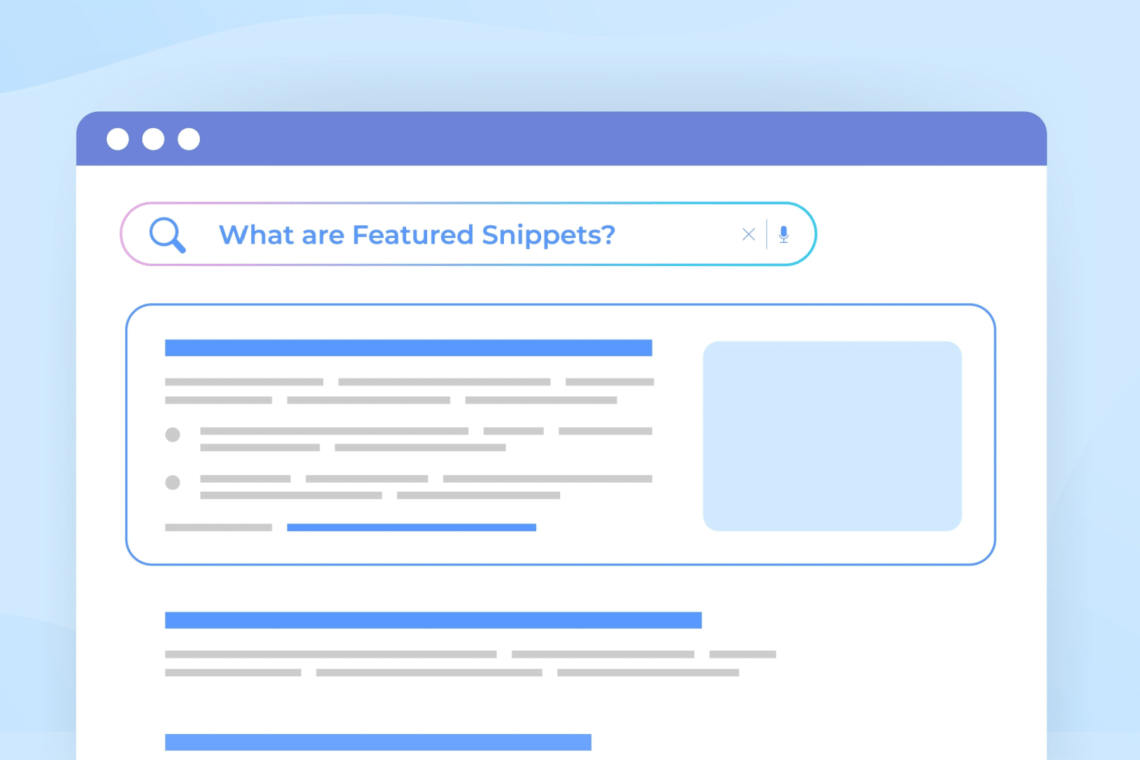How to optimize your content strategy for Google SERP features
[ad_1]
Want to know the most effective ways to harness the full potential of Google’s SERP features?
Learn how your brand can adopt a strategic approach to enhance visibility and secure inclusion within these vital result types.
Common Google SERP features today
When Google updates its search engine ranking algorithm or adds new features, its end goal is to help organize information better for users.
SERP features accomplish this by visually highlighting answers above-the-fold that are most likely to match a user’s inquiry.
Some of the most common SERP features include:
Featured snippets
- Highlighted information that is displayed at the top of the results page, providing bolded answers to user queries.
Knowledge panels
- Panels that appear on the right side of the search results offer information about specific entities such as businesses, celebrities or landmarks.
Local packs
- Listings of local businesses relevant to the user’s search query, including address, phone number, and reviews. These also appear on the right side of the result’s page on desktop or at the top of the page on mobile devices.
Image packs and video carousels
- Collections of images related to the query displayed prominently in the search results or horizontal lists of videos related to it, enabling users to preview and watch them directly from the search results page. These can appear anywhere on the results page.
Site links
- Additional links to the same domains displayed beneath the main search result, directing users to specific sections or pages within a website.
People also ask
- Expandable question boxes, with additional related questions and answers based on the user’s initial search query. Answers can link to the same, or different domains.
Rich snippets
- Also known as “rich results,” these appear similar to traditional search results but display additional information, such as star ratings, pricing, or availability, providing users with more context.
Reviews
- Ratings and reviews displayed alongside business listings, offering users insights into how other members of the public rate the quality of products or services.
Remember that while these SERP features might appear to some users more often, their availability will vary depending on the user’s location, search query and device.
Other result types, like job and event listings or flights and hotels, will only appear for a specific inquiry type.
Get the daily newsletter search marketers rely on.
Optimizing SEO content for featured snippets
Featured snippets are among the most common and sought-after forms of SERP features. They typically consist of three main components:
- Title.
- Content snippet.
- URL source.
The title represents a concise summary of the information, while the content snippet provides a brief answer or solution to the user’s query. The URL source indicates the website from which the information is pulled.
To optimize your content for featured snippets, it is vital to create concise, well-structured information that addresses common user queries.
For instance, if your website offers cooking recipes, you can structure your content by providing step-by-step instructions or bullet-pointed lists that succinctly answer queries.
Optimizing specific on-page elements can significantly enhance your chances of getting featured in snippets.
Start by optimizing your headings and subheadings to indicate the sections containing the answer to the query clearly.
Consider question-based headings (“Can You Cook Salmon in an Air Fryer?”) and answer the question succinctly in the first sentence.
You might also consider generative AI tools like ChatGPT or Google Bard to assist you with crafting perfectly optimized content.
Additionally, implementing structured data markup via schema.org can provide search engines with valuable context and increase the visibility of your content for featured snippets.
To improve your chances of being featured in snippets, consider the following steps:
- Identify common user queries in your industry or niche and create dedicated content to address them comprehensively.
- Focus on long-tail keywords and questions that are more likely to trigger featured snippets.
- Optimize your content for mobile devices, as featured snippets often receive high visibility on mobile search results.
- Leverage visual elements like images, charts, or infographics to make your content more visually appealing and engaging.
Enhancing local SEO with Google’s local packs
Consider the last time you incorporated the phrase “near me” into a Google search.
Regardless of whether you run a restaurant, retail store, or professional service, optimizing your online presence for local searches guarantees that you will be noticed by prospective customers who are actively looking for nearby options.
Many organizations tend to overlook the advantages of local SEO in their overall strategy, even though nearly 98% of people use Google to search for information about local businesses.
This highlights the importance of mastering the basics of Google’s Local Pack features.
At a minimum, you should create and fill out all the fields of your Google My Business profile to the greatest extent possible to secure visibility in Google’s local packs.
Don’t forget to provide accurate and up-to-date information about your business, including address, phone number, hours of operation, and website link, as they are updated.
When it comes to on-page content, to effectively optimize your website for local search queries, start by conducting thorough keyword research that includes location-specific keywords.
For example, if you run a coffee shop in Seattle, target keywords like “best coffee shops in Seattle” or “coffee near me.”
For searchers who allow location targeting, Google is likelier to serve up your business toward the top of the page.
Incorporate these keywords naturally within your meta tags, headings, content and URLs.
Build out location-specific landing pages or blog posts that provide information about your business in relation to the local area, such as highlighting nearby attractions or events.
This is especially important for chains or brands with locations across multiple cities looking to target individual geographic regions.
Leveraging knowledge panels and rich results
Knowledge panels and rich results are powerful SERP features that directly provide information about a person, brand, or topic on the search engine results page.
They offer a snapshot of key details, such as an entity’s description, website, social media profiles, and notable achievements.
Appearing within these types of results can enhance your brand’s credibility by showcasing expertise, authority, and trustworthiness to users.
To optimize your website content for knowledge panels and rich results, start by ensuring that you are providing comprehensive and accurate information about your entity or topic.
As of December 2022, E-A-T expanded to accommodate an additional “E” for experience.
This means content written from a first-hand perspective has a greater chance of ranking. Try to specialize in topics you or your team can write from a place of real-world experience.
Just like featured snippets, entity descriptions that are concise, compelling and succinctly highlight your unique selling points and core expertise are likeliest to get featured.
Structured data markup also plays a pivotal role in enhancing your website content’s visibility for knowledge panels and rich results.
The additional context offered by this code allows search engines to understand and present your information in a more meaningful and visually appealing way.
Earning and maintaining knowledge panel inclusion requires a proactive approach and buy-in from your audience and customer base. Here are some strategies to consider:
- Encourage reputable sources to mention and link to your entity to strengthen your online presence and increases the likelihood of knowledge panel inclusion.
- Cultivate a strong online reputation by actively managing and responding to customer reviews and feedback.
- Regularly update and expand your entity’s information to provide search engines with the most relevant and comprehensive details.
- Monitor your knowledge panel regularly to ensure accuracy and make necessary corrections or updates.
Harnessing visual SERP features (image packs and video carousels)
When it comes to certain types of content, sometimes an article can only take you so far.
It’s no wonder that Google is increasingly prioritizing the inclusion of image packs and video carousels for inquiries that benefit from more of a visual explanation.
Elements such as images, videos, and carousels can significantly enhance your content’s visibility and click-through rates, while providing a more appealing experience for your visitors.
Incorporating high-quality images and videos relevant to your content encourages users to stay on your website longer.
When optimizing this type of multimedia content for Google’s visual SERP features, it is essential to focus on the following aspects:
Images
Use descriptive file names, alt tags, and captions to provide context and improve the discoverability of your images and compress images to optimize loading speed without compromising quality.
Google advises that visual content should be relevant to the page’s topic and not contain any important text embedded within it.
Putting page headings and menu items inside images makes them inaccessible to some users and those using assistive reading devices.
Image alt text and image captions are also required to stay compliant with the Americans with Disabilities Act (ADA) Standards for Accessible Design.
Videos
Optimize video titles, descriptions, and tags with relevant keywords and provide a compelling video thumbnail, considering how it will appear within search results.
Hosting videos on reputable platforms like YouTube or Vimeo is another way to enhance visibility and reach.
Increase the likelihood of your video content being featured in rich snippets or video carousels by implementing structured data markup, such as VideoObject schema, to provide search engines with detailed information.
Google Bard, AI and preparing for the future of SERP features
What will Google Search look like next year? In five years? Ten?
Alphabet CEO Sundar Pichai said the experience “will evolve substantively over the next decade,” which users already see with the introduction of Google Bard and the rapidly evolving world of large language models and generative AI.
Google has introduced the world to Bard, its conversational AI product launched to compete with ChatGPT.
While the experience remains distinct from search, Bard answers can show search and knowledge panels, maps, and even provide local results.
It’s nearly inevitable that the chatbot experience will make its way to Google Search.
As it’s deployed, SEOs should continue to measure how much of an impact it will have on the amount of organic traffic Google sends to sites, and the potential ROI impact for brands and organizations who use Google Ads.
Publishers reliant on ad-based and subscription revenue models have expressed concern about chatbots and AI’s ability to pull and summarize information without users needing to click through to their content.
Add in Bard’s shaky ability thus far to provide sourcing and citations to third-party content, and the ad-based revenue model is looking especially vulnerable.
Ultimately, the greater the number of questions that AI-powered platforms can directly answer using a vast array of sources, the less likely users will visit individual publisher websites, which may or may not provide the desired information.
At this point, Google has underscored its commitment to improving the consumer experience while supporting publishers relying on advertising revenue generated through search referrals.
Still, the long-term ramifications of AI remain to be seen.
Keeping up with the evolution of the search experience and its effect on organic and paid channel performance is part of the course for SEO professionals.
Google has clarified that Bard is not Search, but the two experiences are becoming closer as more AI-powered features are introduced.
When it comes to the search engine results page, some of Google’s newest offerings include Perspectives, which allows searchers to take a deeper dive into creators’ personal experiences, and new markup for site owners to label their images as AI-generated.
Perhaps the biggest change coming to Google is the May 2023 introduction of the new Search Generative Experience (SGE).
Like existing SERP features, AI-powered answers from SGE appear above the first traditional organic result.
The boxed-in answer includes a link to the website source, which users can click, or several “expand” options, which display additional AI responses.
The generative experience also includes the ability for users to converse and provide additional information, with context carried over from question to question.
Google SGE offers a distinctive search experience that builds on the familiar ways searchers are accustomed to interacting with the platform.
As the feature rolls out to the general public, SEOs should proactively monitor their performance to plan for positive or negative effects.
While it’s possible that providing more information within the results page could reduce CTRs and traffic, the SGE could also increase site visits if optimized properly, similar to featured snippets.
The AI discussion parallels the debate that arose when featured snippets were initially introduced.
Publishers and brands should exercise caution when dealing with features that aim to keep users within Google’s ecosystem.
Nevertheless, given the current stage of technology’s development, it would be wise to consider testing the capabilities of appearing before new audiences.
This is particularly relevant for ecommerce businesses. Google’s SGE can aggregate 35 billion product listings from the Google Shopping Graph, offering a potentially powerful means to connect with fresh consumer bases.
Google SERP features today and beyond
SEO continues to evolve rapidly, alongside the increasing importance of SERP features for enhancing user experience.
We must adapt and optimize our strategies to leverage these features effectively, ensuring maximum visibility and reaching our target audience.
Planning a strategy now for existing SERP features is a great way to maximize your organic presence and the best strategy for staying ahead of future advancements in AI and conversational technology.
Keep a close eye on the impact of AI-powered answers on organic traffic and ROI.
As the search landscape continues to evolve, embracing the future of AI and conversational technology will be key to staying competitive and driving success in the digital space.
Opinions expressed in this article are those of the guest author and not necessarily Search Engine Land. Staff authors are listed here.
[ad_2]
Source link





